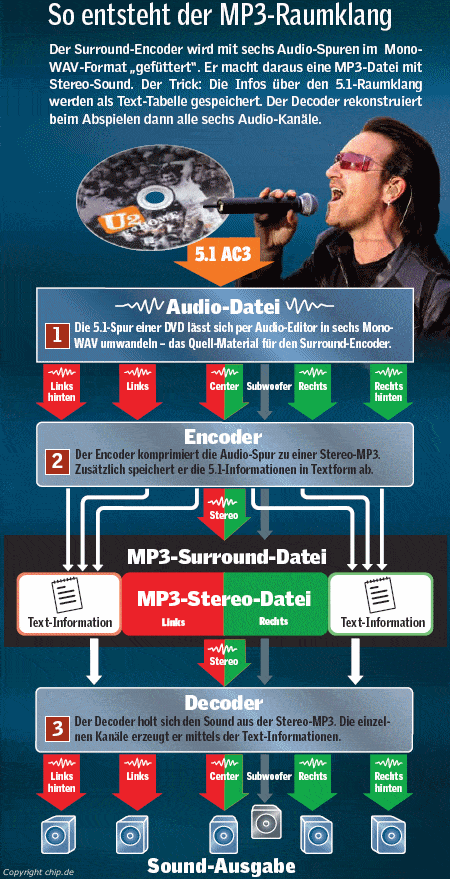If you've listened to MP3s before, you could only do so in stereo. The reason is very simple: The MP3-Standard knows unlike other codecs, such as Apple's AAC, no surround output. This and much more will change with MP3 Surround. The new Codec also has decisive advantages over the AAC mentioned above, because this codec transmits six real channels, which requires storage space accordingly. MP3 surround is limited to two channels and adds the surround sound information as text.
The only remaining advantage for AAC is efficiency, because the format inherently requires less storage space than MP3. However, if they were to use the same technology as MP3 Surround, their files would be much smaller without an audible loss in quality.
But how does the transfer of spatial sound information as text work?
The codec converts a 5.1 sound into a stereoTon and packs the spatial sound information in a table. This is a bit extensive, but only requires one bitrate of 15 kbit/s. If you then play the song, the Decoder Your player restores the 5.1 sound thanks to the surround sound information from the stereo track.
In detail, the encoding of MP3 surround works like this:
Contents
MP3 encoding:
As the starting material for the MP3 surround sound a 5.1 source must be available, e.g. B. the AC3 soundtrack of a musicDVD. However, this must first be broken down into six mono WAV tracks using an audio editor (e.g. MAGIX Music Maker). From the source material, the surroundEncoder then a conventional stereo MP3.
The typical techniques for data reduction are also used here: the encoder identifies and deletes the tones that are covered by others as well as the sounds in the higher range frequency rangethat the human ear can no longer perceive. It is then compressed at the bit level. All in all, the encoder reduces the six mono WAV channels to about one-thirtieth of their original size.
Surround encoding:
The encoder now writes the surround sound information to a text file, which the decoder needs to restore the surround sound. The left audio track becomes the Channel left front, left back and half the center channel. The whole thing is also done for the right channel according to this pattern. The low-frequency effectSignalwhich of the Subwoofer plays, however, does not undergo any BCC analysis. The reason is that frequencies between 20 and 100 Hertz cannot be localized by the human ear. The deep tones are sent to the subwoofer anyway when the decoder is playing.
The above table, in which the spatial sound information is stored in text form, is stored by the encoder in the "ancillary data field" of the MP3 file. This location is usually reserved for the additional features such as the ID3 tag display.
MP3 Sound Decoding:
only one surround decoder is also able to evaluate the information from the surround encoding. The player applies the information from the table to the respective stereo channel. This will reconstruct how the Klang to sound in the front or rear speakers. The center channel is generated from the two stereo audio tracks.
Innovative idea with small quirks:
However, this new format has two problems. The first problem is that the new method is not suitable for the masses and it probably won't be either, because who has the time and the know-how to split a surround source into six mono WAVs? Most people actually use MP3 for archiving their CDs. In addition, there is still no hardware player for playing these formats.

